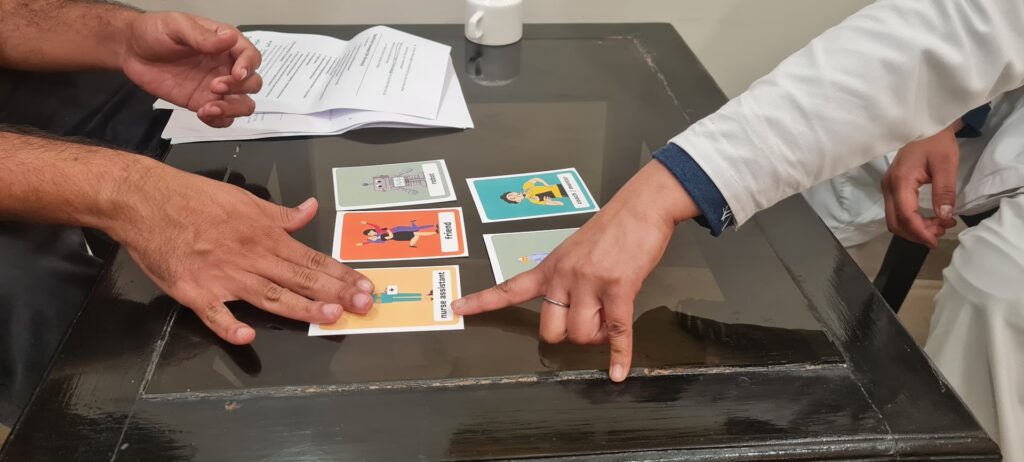

Keeping nurses at the center of healthcare design
Seven principles to consider.
At Noora Health, nurses are the bedrock of our flagship Care Companion Program. They’re the ones who are responsible for training family caregivers on important, life-saving skills. Since Noora Health’s inception, we have prioritized understanding nurses and the hospitals and health settings where they work, so that together we could create impactful learning moments for caregivers and patients.
Last year, as we set out to build an app tailored for the nurses who deliver our programs, we wanted to learn even more about the needs and lives of nurses working in government hospitals across India — their hopes, dreams, and challenges. That’s when Project Nightingales was born.
We developed a six-month, cross-team project led by the Caregiving Lab to explore the question: “How might we understand the care nurses need at the workplace to be torchbearers of the caregiving movement?”
We conducted analogous research, extreme user interviews, and in-depth one-on-ones with nurses in many contexts. After this, we spent time synthesizing our learnings, gathering and framing our insights, and gut-checking our assumptions with nurses at crucial steps along the way.
What we discovered were seven design principles that we believe anyone working with nurses should keep in mind. These principles are not just abstract concepts but are rooted in the lived experiences of nurses on the ground. They represent a new way of thinking about how to design human-centered solutions that truly meet the needs of nurses and healthcare workers, both in India and beyond.
1. Trust nurses’ expertise
If you’re designing a product or service that is related to a hospital, there is no one with more wisdom on what would work and what would fail than a nurse. From early on in the design process, tap into their wisdom to make critical decisions, especially about:
- The flow of work in the hospital
- The on-ground priorities of the hospital
- How and what to contextualize for the patients in the regions served by the hospital
2. Design products and services that give nurses autonomy
Ever too often, nurses — who are the backbone of hospitals — feel a chronic lack of control over the work they do. They typically don’t have the authority to make decisions and mainly function to execute orders from higher authorities, on the ground.
We heard many nurses feel fatalistic about this lack of power, saying “What can we do? You just get used to it”.
When designing for nurses, ensure you give them autonomy over when and how they use your tools. This will not only give nurses back their power and allow them to adapt your product to their needs, but will also ensure that what you’re building is sustainable.
3. Pay attention to the larger context nurses work in
There’s practically nothing you can ask a nurse to do that’s not already on their job description. Why? Because, in an effort to improve public health, the healthcare system has undergone many transformations. There are more types of medications and procedures, more insurance schemes, more public interventions and programs, and more services than ever before. And the best person to do it all? The nurse!
There’s too much that’s on their plate already, and it’s all equally important. When you’re designing for a nurse, try not to add tasks to their already burgeoning list of things to do. Instead, focus on opportunities to:
- Remove ‘non-patient care’ tasks such as administrative work, organization and coordination, and data collection and presentation
- Consolidate and simplify tasks
4. Keep time constraints in mind
The role of a nurse is incredibly responsive and reactive. They typically context switch tens or hundreds of times, and don’t have a lot of control over when or how this switch happens. One minute they are filling out paperwork, and the next minute they have to drop everything to attend to a critical patient. Keeping this in mind, design for the dynamic movement of the nurses, knowing that:
- They may not be able to dedicate longer than 10–15 minutes at a time to your product or service
- They may not be able to reliably predict when they would use your product or service

5. Find ways to share responsibility
Alongside being the backbone of the hospital, nurses are also the face of it. And so, if something goes wrong, they are the first to feel the heat. Nurses are already on the receiving end of a lot of frustration, expectation, fear, and anxiety from patients, their families, and even administrative staff. When designing a product or service that is delivered via a nurse, bake in a representative to address grievances in place of the nurse. This not only takes some of the pressure off the nurse, it also ensures you receive direct, unfiltered feedback from the end-user as well.
6. Focus on the overall well-being of nurses, not just task completion
A day in the life of a nurse seems to be designed for emotional burnout. They are expected to transition seamlessly between multiple emotionally charged and sometimes traumatic experiences, and deal with the personal consequences in their own time. The hospital is not a work environment conducive to prioritizing personal health and well-being. As people or teams designing for nurses, it is our job to create opportunities within our products and services that allow and encourage nurses to prioritize themselves.
7. Build in opportunities for feedback and grievance resolution
Within hospitals, we saw many instances of nurses not having opportunities to advocate for themselves. From smaller concerns like their changing stations being taken away to larger issues like workplace harassment, nurses have historically been on the receiving end of a broken grievance redressal system. When designing for nurses, it is crucial to design genuine opportunities for nurses to raise challenges and seek redressal when the product or service is not working for them.
At Noora Health, we have translated these insights into key mindset shifts that we need to make as an organization. These shifts will, in turn, inform the products we build and how we build them. At the time of writing of this post, we are in the process of conducting a series of workshops that will not only help us disseminate these shifts throughout the organization, but also turn them into concrete ideas for products, processes, and policies we can instate to serve our nurses better.
How have these principles shown up in your work? Write to us at caregivinglab@noorahealth.org and let’s keep the conversation going!




